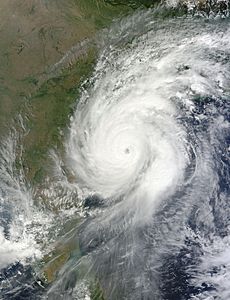Cyclone Hudhud facts for kids
Cyclone Hudhud was a really powerful and dangerous storm. It started in the northern part of the Indian Ocean in October 2014. This huge storm brought very strong winds and heavy rain. It caused a lot of damage and sadly, many people were affected across India.
Contents
Understanding Cyclone Hudhud
A cyclone is a giant spinning storm system. It forms over warm ocean waters. Cyclone Hudhud was an "extremely severe cyclonic storm." This means it was one of the strongest types of cyclones. It had very powerful winds and caused a lot of destruction.
Where Did Hudhud Form?
Cyclone Hudhud began as a low-pressure area. This happened over the Andaman Sea in the northern Indian Ocean. It slowly grew stronger as it moved west. The warm ocean waters helped it gain power. It became a full cyclone by October 8, 2014.
How Strong Was the Storm?
Hudhud became very strong. Its winds reached speeds of almost 130 miles per hour (210 kilometers per hour). This is like a very fast train! These strong winds can easily blow away roofs and trees. The storm also brought very heavy rainfall.
What Happened When Hudhud Hit Land?
On October 12, 2014, Cyclone Hudhud hit the coast of Andhra Pradesh, India. It made landfall near the city of Visakhapatnam. The city faced the full force of the storm. Strong winds and heavy rain caused widespread damage.
- Many homes and buildings were damaged.
- Trees were uprooted, blocking roads.
- Power lines were knocked down, causing blackouts.
- Sadly, more than 100 people lost their lives because of the storm.
The storm also affected other areas. These included parts of Odisha in India and even Nepal. In Nepal, the storm's heavy rains caused avalanches.
The Cost of the Storm
Cyclone Hudhud caused a huge amount of damage. The total cost was estimated to be about $11 billion (USD). This money was needed to repair homes, roads, and other buildings. It also helped people get back on their feet. Many people worked together to help the affected areas recover.
Images for kids





